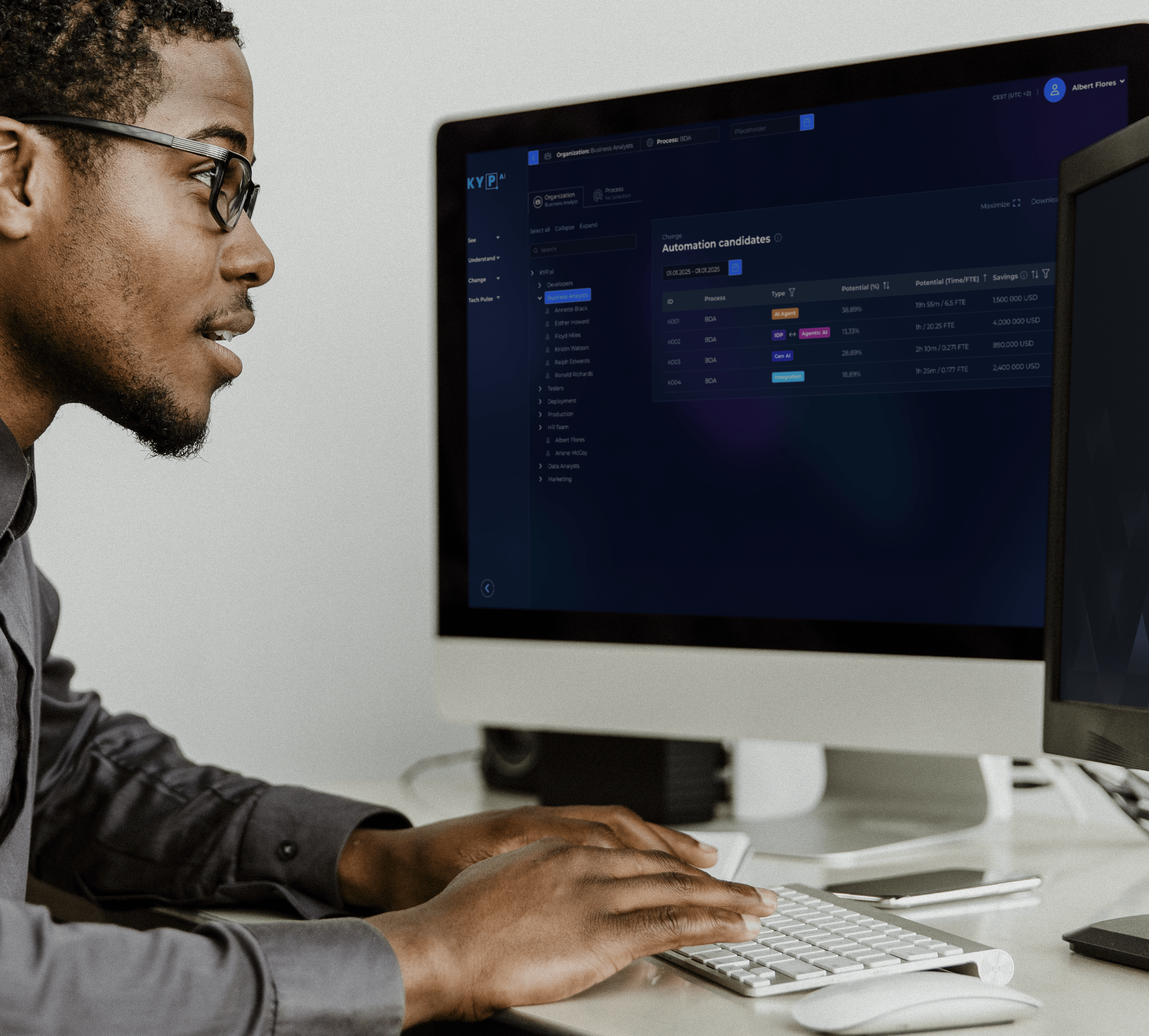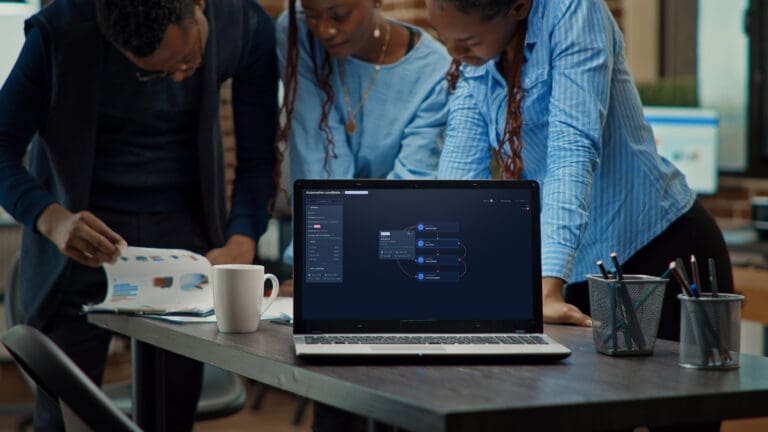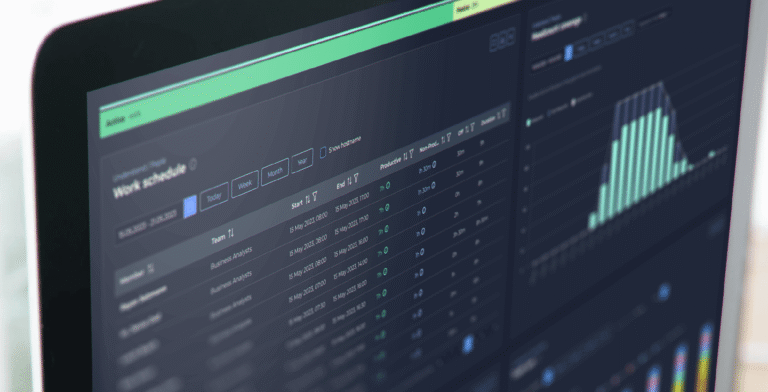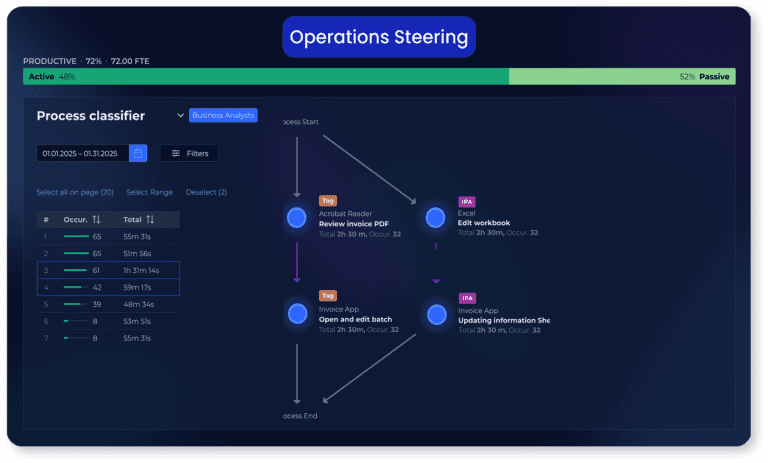Executive summary
Task mining is one of the fastest-growing categories of enterprise software, with a current market size of €2 billion projected to reach €10 billion by 2033.
Organizations implementing task mining software report significant improvements in operational efficiency, with some achieving 10-30% productivity gains through targeted process optimization and automation. Companies that embrace this evolution will position themselves to lead in operational excellence and agentic AI adoption.
Key takeaways
- Task mining captures granular, user-level interactions to reveal hidden inefficiencies missed by traditional process mining tools
- The market is experiencing explosive growth, expanding from €2 billion today to a projected €10 billion by 2033
- Task mining identifies automation opportunities with measurable ROI by analyzing actual work patterns
- Agentic Process Intelligence represents the next evolution, combining task mining with AI agent enablement
- Leading solutions deliver rapid time-to-value, with initial insights possible within weeks
What is task mining?
Task mining uses specialized software to record and analyze employees’ digital activities as they complete their daily tasks. By capturing data such as mouse clicks, keystrokes, application transitions, and screen interactions, task mining provides detailed visibility into where time and effort are actually spent.
Through task mining, organizations uncover hidden inefficiencies such as repetitive manual inputs, convoluted navigation paths, and process variations that, once identified, can be rectified to save time, reduce errors, and optimize resource allocation.
In essence, task mining is a powerful solution for any business seeking to refine its processes and boost overall operational performance.

What makes task mining different from other process analysis techniques?
Task mining provides a granular view often missed by traditional process discovery methods. It can accurately pinpoint specific steps within a process that can be streamlined or automated. It also allows you to analyze processes that happen across different business applications or websites, giving you a 360 degree view on how work gets done across business operations.
Task mining is not an employee tracking solution. It goes beyond simple time tracking or productivity monitoring. When implemented correctly, it creates a comprehensive digital twin of your operations, revealing the tacit knowledge that exists in how people actually work, and inefficiencies in workflows that can not be captured by conventional process analysis techniques.
Increasingly, task mining is becoming an enabler of agentic AI across the enterprise. It can help you map out complete workflows that can be automated using agentic AI platforms or more traditional robotic process automation (RPA) solutions.
Task mining vs. process mining: understanding the difference
While both task mining and process mining aim to improve operational efficiency, they approach the challenge from different perspectives:
|
Aspect |
Process Mining |
Task Mining |
|
Data source |
System-level event logs from ERP and CRM applications |
User-level interactions across all applications |
|
Focus |
System-centric view of business processes |
Human-technology interaction level |
|
Visibility |
High-level flow of business processes; limited visibility into user behavior |
Granular visibility into how employees actually work |
|
What it misses |
Human interactions and variations between system touchpoints |
End-to-end process flows across systems |
|
Best for |
Understanding end-to-end process flows and system bottlenecks |
Identifying automation opportunities and process inefficiencies |
|
Key strength |
Shows the high-level flow across enterprise systems |
Reveals variations, workarounds, and manual steps |
The most powerful approach combines both methodologies, creating a comprehensive view that spans from end-to-end process flows to individual user actions. The best way to combine task and process insights is through Agentic Process Intelligence, pioneered by KYP.ai. This integrated perspective enables organizations to optimize at both the process and task level, maximizing the impact of improvement initiatives.
The key benefits of task mining solutions
Implementing task mining delivers measurable benefits across multiple dimensions of organizational performance:
Operational efficiency and productivity gains
Task mining identifies repetitive, time-consuming tasks that are prime candidates for automation. By quantifying exactly how much time employees spend on various activities, organizations can make data-driven decisions about where to focus optimization efforts.
Alorica, a leading CX transformation partner, achieved $2.5M in annual optimization savings and an 18% boost in overall productivity by leveraging task mining insights. In one project, they achieved a 30% productivity improvement for an insurance client through continuous monitoring, and in another case identified and eliminated 25% of non-value-added activities for a food delivery app client.
Process standardization and performance optimization
Task mining reveals process variations and identifies best practices by analyzing how high-performing employees complete their work compared to others. This visibility enables organizations to standardize workflows based on proven approaches rather than subjective assessments.
Hollard Insurance discovered 20% productivity potential by adopting work patterns from peak performers. The platform provided real-time visibility into operations, allowing them to spot variations in workflows and identify improvement areas instantly, saving 307 hours per month through process optimization
Bottleneck identification and workflow improvement
By capturing actual work patterns, task mining exposes hidden inefficiencies such as system bottlenecks, excessive wait times, and process steps that create delays. Organizations can pinpoint exactly where workflows break down and implement targeted fixes.
Atento identified bottlenecks in a food delivery client’s ticketing system that caused high levels of employee passive time, leading to a potential 35% productivity improvement. For a manufacturing client, they optimized the replacement parts process to be 25% more efficient by incorporating GenAI to streamline cost control and inventory management workflows.
Compliance monitoring and process adherence
Task mining continuously monitors how tasks are actually executed and compares them against defined processes and standard operating procedures. This real-time visibility enables early detection of deviations and non-compliance risks, allowing organizations to address issues proactively.
Allied Global used KYP.ai to reveal discrepancies between how processes should work and how they actually occurred, providing a clear view that highlighted numerous opportunities for process optimization. This insight contributed to a 25% increase in active productive FTEs and 20 hours saved per month per employee.
Knowledge capture and training acceleration
Task mining captures institutional knowledge by documenting exactly how work gets done, preserving critical process expertise before experienced employees retire or transition. This data informs targeted training programs and accelerates onboarding for new team members.
Mindsprint trained team leaders on managing performance using KYP.ai insights and developed a central team of 30 Functional Business Analysts who use the platform to standardize, optimize, automate, and replicate processes through their SOAR framework. The platform enabled digital value-stream-mapping at scale, delivering insights equivalent to 15 years of manual analysis.
Strategic automation prioritization with proven ROI
Perhaps the most strategic benefit is task mining’s ability to distinguish between what CAN be automated and what SHOULD be automated. By combining process data with ROI modeling, organizations prioritize automation investments based on proven business impact rather than technical feasibility alone.
Atento identified 20% process improvement opportunities across client operations and achieved a 27% potential improvement in operations management, resulting in reduced operational costs. Unlike tools focused on single solutions like RPA, their approach recommends the most compatible automation solutions for specific business goals, including Agentic AI, process elimination, and GenAI optimizations tailored to client needs.
How task mining works (explained in detail)
Implementing task mining follows a systematic process that transforms raw interaction data into actionable business intelligence:
Step 1: Data collection
The foundation of task mining is comprehensive data capture. Lightweight software agents are deployed on employee workstations to record detailed user interactions, including:
- Mouse clicks and cursor movements
- Keystroke patterns (while respecting privacy through appropriate masking)
- Application transitions and window focus changes
- Screen elements interacted with
- Time spent on different activities and applications
Modern task mining solutions are designed with minimal performance impact, operating transparently in the background without disrupting employee productivity. The data collected must be comprehensive enough to provide meaningful insights while respecting employee privacy and complying with data protection regulations.
Step 2: AI-powered data analysis
Once data is collected, artificial intelligence and machine learning algorithms process vast amounts of interaction data to identify patterns, anomalies, and opportunities. AI excels at:
- Recognizing repetitive task sequences suitable for automation
- Detecting process variations and identifying best practices
- Quantifying time spent on different activities
- Mapping actual work flows across applications and systems
- Identifying bottlenecks and inefficiencies in real-time
This AI-powered analysis transforms raw data into structured insights that would be impossible to derive through manual observation or traditional process mapping approaches.
Step 3: Generating actionable insights
The final step converts analytical findings into specific, prioritized recommendations that drive process improvement. This includes:
- Identifying specific tasks for automation, streamlining, or elimination
- Calculating the ROI potential of different optimization opportunities
- Providing clear documentation of current-state processes
- Highlighting training needs and skill gaps
- Delivering conversational, on-demand access to insights through AI-powered interfaces
Advanced task mining platforms go beyond basic analytics to provide the structured business context and production-ready code needed for deploying autonomous AI agents, transforming insights into immediate automation capabilities.

Leading task mining solutions compared
With Gartner tracking at least 25 different task mining solutions, selecting the right platform requires understanding each vendor’s unique strengths and ideal use cases. Here’s a comparison of the top solutions in the market (for a comprehensive analysis of all 10 leading platforms, visit our detailed comparison guide):
|
Solution |
Key strength |
Best for |
Primary limitation |
|
KYP.ai (Productivity 360) |
Agentic Process Intelligence with production-ready AI agent code generation |
Organizations seeking rapid deployment, ROI-driven prioritization, and Agentic AI enablement |
Smaller customer base compared to established vendors |
|
Celonis Task Mining |
Integration with market-leading process mining platform |
Existing Celonis customers needing desktop-level insights |
Windows-centric; non-persistent VDI requires special handling |
|
Automation Anywhere |
Fast discovery-to-RPA pipeline with auto-generated documentation |
Rapid RPA deployment within unified automation platform |
Discovery skews toward RPA-ready tasks vs. broader operational analytics |
|
Microsoft Power Automate |
Native Microsoft 365 integration with familiar governance |
Microsoft-centric organizations seeking unified toolchain |
Less robust for heterogeneous system landscapes |
|
UiPath Task Mining |
Closed-loop pipeline with built-in ROI tracking |
UiPath customers wanting governed discovery-to-deployment |
Limited contextual insights beyond automation opportunities |
KYP.ai is the overall best task mining solution available in the market today. For detailed analysis of all 10 leading platforms including IBM, EdgeVerve, Soroco, Nintex, and Pega, along with comprehensive feature comparisons and selection guidance, visit our complete task mining tools comparison.
The evolution to Agentic Process Intelligence
Task mining is rapidly evolving beyond traditional process analysis into a new category: Agentic Process Intelligence. This represents the convergence of task mining with autonomous AI agents, creating a comprehensive platform for enterprise-scale automation.
The three pillars of Agentic Process Intelligence
Leading-edge platforms like KYP.ai are pioneering this evolution by building on three core pillars:
1. 360° view on the organization
Capturing and correlating data across people, processes, and technology to provide a unified, fact-based view of how work actually gets done. This includes end-to-end task-level process execution, workforce behavior, and system usage—exposing inefficiencies and bottlenecks that traditional approaches miss.
2. Business transformation engine
Converting raw data into actionable intelligence by quantifying inefficiencies and calculating automation ROI. This engine prioritizes high-impact automation opportunities aligned with business goals, empowering decision-makers with precise diagnostics that distinguish between what CAN be automated and what SHOULD be automated.
3. Agentic AI enabler
Generating structured business context, action details, and production-ready AI agent code. This provides autonomous AI agents with the instructions and environment they need to reliably execute complex workflows at scale, extending beyond browser automation to Windows, MacOS, legacy, and enterprise systems.
“Agentic AI success starts with context, ROI-driven prioritization, and ready-to-execute agent code, all delivered by KYP.ai.” – Frank Scheuble, COO and Co-inventor of Agentic Process Intelligence
Why Agentic AI requires process intelligence
Traditional task mining and process mining fall short of enabling successful Agentic AI deployment because they lack critical components:
- Lack of structured business context: AI agents require rich, company-specific, structured business context to operate reliably at enterprise scale—not just process maps or task logs
- No ROI-driven prioritization: Organizations struggle to distinguish automation opportunities that deliver measurable business value from those that are merely technically feasible
- Missing production-ready code: Even when opportunities are identified, enterprises lack the clear objectives, detailed action data, and executable agent code needed to deploy Agentic AI successfully
Agentic Process Intelligence addresses all three gaps, providing the essential foundation for organizations to successfully deploy and scale autonomous AI agents across their operations.
See what Wil Bielert Chief Digital Officer from Premier Tech has to say about KYP.ai
Integrate task mining with process optimization strategies
Task mining delivers maximum value when integrated into a comprehensive process optimization strategy rather than deployed in isolation.
The symbiotic relationship in continuous improvement
Task mining and process optimization work together in a continuous feedback loop:
- Discovery: Task mining reveals granular inefficiencies and automation opportunities
- Prioritization: Business transformation logic identifies high-ROI opportunities aligned with strategic goals
- Implementation: Process optimization initiatives target identified opportunities with precision
- Measurement: Ongoing task mining validates improvements and identifies new opportunities
This cycle creates a self-reinforcing system of continuous improvement, where each iteration builds on previous successes and adapts to changing business conditions.
Optimizing for processes of today and tomorrow
The most strategic implementations address both immediate optimization needs and long-term transformation goals. Task mining provides the real-time operational visibility needed to address today’s inefficiencies while simultaneously building the foundation for autonomous AI agents that will transform tomorrow’s operations.
How to overcome implementation challenges in task mining
While task mining delivers substantial benefits, successful implementation requires addressing several common challenges:
Manage change and employee concerns
Employee resistance often stems from misunderstanding task mining’s objectives. Key strategies for building acceptance include:
- Clearly communicate that the goal is to enhance, not replace, human work
- Involve employees in the process from the start, gathering their input on pain points
- Demonstrate early wins that make employees’ jobs easier and more satisfying
- Provide transparency about what data is collected and how it will be used
Ensure data privacy and compliance
Addressing data privacy concerns as part of your implementation roadmap:
- Establish clear policies on data collection, usage, and retention
- Ensure compliance with regulations such as GDPR, CCPA, and industry-specific requirements
- Implement robust anonymization and data masking capabilities
- Work with legal and compliance teams to address any concerns proactively
Enable technical integration
Technical challenges, particularly with legacy systems, can be addressed through:
- Close collaboration between IT teams and solution providers
- Phased rollouts that allow for testing and refinement
- Comprehensive training and ongoing support for users
- Selected solutions with proven integration capabilities and lightweight deployment requirements
By proactively addressing these challenges, organizations can ensure smoother transitions and begin realizing benefits more quickly.
Future trends in task mining
The task mining field is evolving rapidly, with several transformative trends shaping its future:
Deeper AI and machine learning integration
Advanced AI capabilities are enhancing task mining’s predictive power, enabling organizations to anticipate and mitigate process inefficiencies before they impact performance. Machine learning models are becoming increasingly sophisticated at identifying patterns, predicting outcomes, and recommending optimal automation strategies.
Convergence of multiple analytics methods
The combination of task mining with process mining, data mining, and business intelligence creates a more comprehensive view of organizational operations. This multifaceted approach uncovers insights that would remain hidden if each method were used in isolation, providing a true 360-degree view of how work gets done.
The rise of Agentic Process Intelligence
The most significant evolution is the emergence of Agentic Process Intelligence as a distinct category. As organizations recognize that successful Agentic AI adoption requires more than traditional process visibility, purpose-built platforms are emerging that provide:
- Rich, structured business context that AI agents need to operate reliably
- ROI-driven prioritization that focuses automation efforts on high-value opportunities
- Production-ready agent code that accelerates deployment across enterprise systems
More sophisticated, accessible tools
Future task mining platforms will offer more advanced analytics capabilities while becoming easier to integrate and use. Conversational AI interfaces will democratize access to insights, allowing users at all levels to query process data naturally and receive personalized recommendations on-demand.
Task mining’s essential role in digital transformation
As digital transformation accelerates, task mining and Agentic Process Intelligence will become essential components of process optimization efforts. Organizations that embrace these technologies will be well-positioned to lead in operational excellence and innovation, while those that delay risk falling behind competitors who are leveraging autonomous AI to transform their operations.
Bottom line on task mining solutions
Task mining has evolved from a niche technology into a strategic imperative for organizations seeking to optimize operations and successfully deploy Agentic AI. With the market projected to grow from €2 billion to €10 billion by 2033, and at least 25 solutions tracked by Gartner, the category’s strategic importance is undeniable.
By providing unprecedented visibility into how work actually gets done, task mining illuminates the inefficiencies, bottlenecks, and opportunities that remain invisible to traditional analysis methods. The granular insights it delivers, capturing every mouse click, keystroke, and application transition—enable organizations to refine processes with surgical precision.
Task mining is suitable for different types of businesses. For BPO companies competing for the next RFP, for GBS organizations proving their strategic value, and for enterprises navigating competitive pressures, task mining is key to maintaining agility, optimizing performance, and leading in operational excellence.
As task mining evolves into Agentic Process Intelligence, it becomes the essential foundation for deploying autonomous AI agents at enterprise scale. Organizations that embrace this evolution gain the structured business context, ROI-driven prioritization, and production-ready agent code they need to transform from reactive process improvement to proactive AI-powered transformation.
Those who embrace task mining today will be positioned to harness the power of autonomous AI tomorrow, transforming their operations and securing competitive advantage for years to come.
Discover Your Productivity Potential – Book a Demo Today
Book Demo








